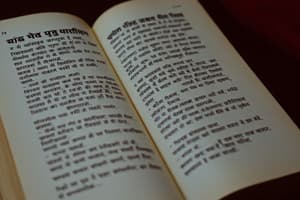Podcast
Questions and Answers
What aspect has significantly influenced the evolution of Bengali literature?
What aspect has significantly influenced the evolution of Bengali literature?
- Globalization of Western literature
- Only religious traditions
- Historical periods and regional movements (correct)
- The decline of formal education
What is a critical factor in the variation of Bengali language usage?
What is a critical factor in the variation of Bengali language usage?
- Different levels of formality in speech (correct)
- The absence of dialects
- The intensity of globalization
- Strict grammatical rules
How does modern Bengali adapt to contemporary society?
How does modern Bengali adapt to contemporary society?
- Maintaining a static form unchanged by technology
- By enforcing traditional grammar rules
- Through the adoption of new words and expressions from international languages (correct)
- By discarding old vocabulary entirely
In which context does Bengali hold significant cultural importance?
In which context does Bengali hold significant cultural importance?
What contributes to the practical application of the Bengali language?
What contributes to the practical application of the Bengali language?
What script is the Bengali alphabet derived from?
What script is the Bengali alphabet derived from?
What is the general word order of Bengali sentences?
What is the general word order of Bengali sentences?
Which of the following statements is true regarding Bengali vowels?
Which of the following statements is true regarding Bengali vowels?
What type of variations are found in the Bengali language?
What type of variations are found in the Bengali language?
What is one characteristic feature of Bengali phonology?
What is one characteristic feature of Bengali phonology?
How does Bengali express different tenses and moods of verbs?
How does Bengali express different tenses and moods of verbs?
What role do inflectional suffixes play in Bengali grammar?
What role do inflectional suffixes play in Bengali grammar?
Which statement best describes the literary tradition of Bengali?
Which statement best describes the literary tradition of Bengali?
Flashcards
Formality in Bengali
Formality in Bengali
Different speech styles based on context and relationships. It's like switching between formal and informal language.
Bengali's Cultural Importance
Bengali's Cultural Importance
Bengali language's influence on everyday life in Bangladesh and West Bengal, including cultural traditions, religion and daily routines.
Modern Bengali
Modern Bengali
The evolving nature of Bengali, incorporating new words and expressions from other languages and modern technologies.
Bengali Literature's Historical Context
Bengali Literature's Historical Context
Signup and view all the flashcards
Sociolinguistics of Bengali
Sociolinguistics of Bengali
Signup and view all the flashcards
What is Bengali?
What is Bengali?
Signup and view all the flashcards
What are the components of the Bengali alphabet?
What are the components of the Bengali alphabet?
Signup and view all the flashcards
How are vowel sounds modified in Bengali?
How are vowel sounds modified in Bengali?
Signup and view all the flashcards
What are some key features of Bengali phonetics?
What are some key features of Bengali phonetics?
Signup and view all the flashcards
How does Bengali grammar structure sentences?
How does Bengali grammar structure sentences?
Signup and view all the flashcards
What are Bengali dialects and why do they exist?
What are Bengali dialects and why do they exist?
Signup and view all the flashcards
What is the significance of Bengali literature?
What is the significance of Bengali literature?
Signup and view all the flashcards
Study Notes
Bengali Language Overview
- Bengali is an Indo-Aryan language spoken primarily in Bangladesh and the Indian state of West Bengal.
- It has a rich literary tradition spanning centuries, with significant contributions to poetry, prose, and drama.
- The Bengali script is derived from the Brahmi script, and is distinct from other scripts like Devanagari.
- It is written both vertically and horizontally.
- A significant number of Bengali speakers reside in other parts of the world due to diaspora communities.
Bengali Alphabet
- The Bengali alphabet consists of vowels and consonants.
- There are distinct forms for each consonant depending on the preceding vowel.
- Vowels are primarily used for vocal articulation within consonants rather than stand-alone characters.
- Bengali employs diacritics to modify the inherent vowel sounds of consonants.
- Each letter has specific shapes and combinations for different vowel conjugations.
Phonology
- Bengali has a complex phonological system with a variety of vowels and consonants.
- The language distinguishes between aspirated and unaspirated consonants.
- There are specific rules for combining consonants and vowels to form syllables.
- It features a distinct tonal quality, reflected in the pronunciations of words.
- The pronunciation and use of specific characters may vary across regions and dialects.
Grammar
- Bengali grammar generally follows an SOV (subject-object-verb) word order.
- The language uses prefixes and suffixes to change tenses and moods of verbs.
- Gender distinctions in nouns are present (masculine, feminine, and neuter).
- Inflectional suffixes are crucial for expressing grammatical relations.
- Formal and informal grammatical forms exist indicating politeness or familiarity.
Dialects
- Bengali exhibits regional variations in vocabulary and pronunciation.
- Different dialects develop over time due to geographic segregation and cultural influences.
- Differences in vocabulary, grammatical structures, and pronunciation create distinct dialectal varieties.
- Dialectal differences can be significant enough to cause communication issues between speakers of different dialect groups.
- Examples of notable dialects include those in different regions of West Bengal, and in Bangladesh.
Literature
- Bengali literature has a long history, reflecting the cultural richness and intellectual heritage of Bengal.
- Classic poems, novels, and short stories are integral to the language's literary tradition.
- Significant Bengali authors have contributed to the realm of global literature.
- The influence of different historical periods and regional movements have impacted Bengali literature throughout centuries.
- Major works of Bengali literature have been translated into various languages.
Sociolinguistics
- Bengali's usage varies based on formality.
- Different levels of formality in speech are crucial for maintaining social etiquette.
- Bengali is a language of great cultural significance for both religious and secular traditions.
- The importance of Bengali in daily life in both Bangladesh and West Bengal, India, demonstrates its continuing usage.
- A complex network of sociolinguistic factors including cultural norms and contexts shape the language's practical application.
Modern Bengali
- Current use of Bengali comprises various forms – from formal written communication to casual conversations.
- The language continues to evolve with incorporating new words and expressions from other international languages.
- The use of the language evolves based on social media usage and technology.
- The application of Bengali shows adaptation to modern technology, education, and daily life.
- The influence of different cultural exchanges contributes to evolving language usage.
Studying That Suits You
Use AI to generate personalized quizzes and flashcards to suit your learning preferences.




